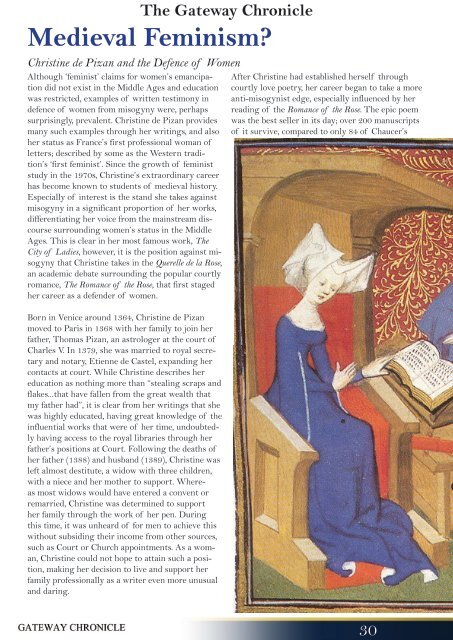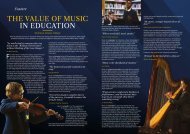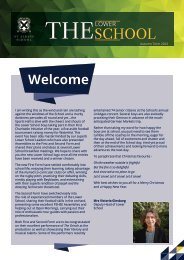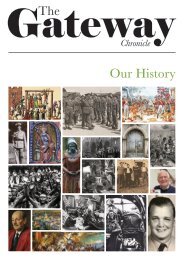Create successful ePaper yourself
Turn your PDF publications into a flip-book with our unique Google optimized e-Paper software.
30<br />
The <strong>Gateway</strong> <strong>Chronicle</strong><br />
Medieval Feminism?<br />
Christine de Pizan and the Defence of Women<br />
Although ‘feminist’ claims for women’s emancipation<br />
did not exist in the Middle Ages and education<br />
was restricted, examples of written testimony in<br />
defence of women from misogyny were, perhaps<br />
surprisingly, prevalent. Christine de Pizan provides<br />
many such examples through her writings, and also<br />
her status as France’s first professional woman of<br />
letters; described by some as the Western tradition’s<br />
‘first feminist’. Since the growth of feminist<br />
study in the 1970s, Christine’s extraordinary career<br />
has become known to students of medieval history.<br />
Especially of interest is the stand she takes against<br />
misogyny in a significant proportion of her works,<br />
differentiating her voice from the mainstream discourse<br />
surrounding women’s status in the Middle<br />
Ages. This is clear in her most famous work, The<br />
City of Ladies, however, it is the position against misogyny<br />
that Christine takes in the Querelle de la Rose,<br />
an academic debate surrounding the popular courtly<br />
romance, The Romance of the Rose, that first staged<br />
her career as a defender of women.<br />
Born in Venice around 1364, Christine de Pizan<br />
moved to Paris in 1368 with her family to join her<br />
father, Thomas Pizan, an astrologer at the court of<br />
Charles V. In 1379, she was married to royal secretary<br />
and notary, Etienne de Castel, expanding her<br />
contacts at court. While Christine describes her<br />
education as nothing more than “stealing scraps and<br />
flakes...that have fallen from the great wealth that<br />
my father had”, it is clear from her writings that she<br />
was highly educated, having great knowledge of the<br />
influential works that were of her time, undoubtedly<br />
having access to the royal libraries through her<br />
father’s positions at Court. Following the deaths of<br />
her father (1388) and husband (1389), Christine was<br />
left almost destitute, a widow with three children,<br />
with a niece and her mother to support. Whereas<br />
most widows would have entered a convent or<br />
remarried, Christine was determined to support<br />
her family through the work of her pen. During<br />
this time, it was unheard of for men to achieve this<br />
without subsiding their income from other sources,<br />
such as Court or Church appointments. As a woman,<br />
Christine could not hope to attain such a position,<br />
making her decision to live and support her<br />
family professionally as a writer even more unusual<br />
and daring.<br />
After Christine had established herself through<br />
courtly love poetry, her career began to take a more<br />
anti-misogynist edge, especially influenced by her<br />
reading of the Romance of the Rose. The epic poem<br />
was the best seller in its day; over 200 manuscripts<br />
of it survive, compared to only 84 of Chaucer’s


















